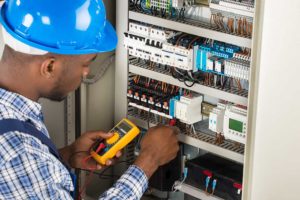Disclaimer: The information on our website is provided for general information purposes only. We make no representations or warranties of any kind, express or implied, about the completeness, accuracy, reliability, suitability or availability with respect to the website or the information contained on our website for any purpose. Any reliance on such information is therefore strictly at your own risk and we are not liable for any damages or losses arising out of or resulting from your reliance on any information contained on our website.
An electrician installs and maintains electrical power for lighting systems, communication systems, wiring and control systems, and appliances. Additionally, they are qualified to inspect electrical components like circuit breakers and transformers and use various testing equipment. Watch a video for a glimpse of an electricians job in the United States Air Force.
How to Become an Electrician
The most common avenue to become an electrician is through an apprenticeship program that consists of 144 hours of technical training and 2,000 hours of paid on-the-job training. This usually takes about 4-5 years to complete, after which a license is usually required according to each state’s regulations. An accredited technical school can be acceptable and have courses in safety practices, circuitry and basic electricity, as well as some math and blueprint reading. Watch another video to learn what an electrician does:
Job Description of an Electrician

An electrician reads blueprints that reveal the location of outlets, circuits, and other equipment. He or she uses a variety of tools for the job, such as hand and power tools like conduit benders, wire strippers, and power tools. They also use tools like ammeters or voltmeters.
There are basically two types of electricians. One type is residential, which typically works in private homes or new home construction. The other type is an inside electrician that works most often in factories or businesses with larger electrical systems. The Bureau of Labor Statistics projects a high growth rate in 2012-2022 in this career field based on new construction growth and alternative powers such as wind and solar energy.
Electrician Career Video Transcript
Behind every light switch or electrical outlet, there is an electrician who made it work. Almost every building has an electrical power, communications, lighting, or control system that electricians and helpers installed when the building was constructed and maintained afterward.
For new construction, electricians read diagrams that show the planned location of circuits, outlets, and other equipment to guide their work. They use hand and power tools to run wiring through walls and protect it. They also test equipment and materials to find problems and ensure components work properly. Maintenance means first finding the problem then accessing it for repairs.
Electricians must carefully follow building regulations to ensure safety, especially when directing or training other workers. Electrician helpers carry materials and tools, cut and bend wire and conduit, use tools to repair and maintain wiring, and clean work areas and equipment. These workers keep full-time hours, sometimes evenings and weekends, working indoors and outdoors in homes, businesses, and construction sites.
Most work for electrical and other wiring contractors. Work can require long periods of standing and kneeling, sometimes in cramped spaces. Most electricians learn their trade in a 4 or 5-year apprenticeship program that combines technical training and paid on-the-job training. Most states require a license. Electrician helpers usually need a high school diploma or equivalent and are trained on-the-job. Electricians and electrician helpers literally help the United States “keep the lights on.”
Article Citations
Bureau of Labor Statistics, U.S. Department of Labor, Occupational Outlook Handbook, Electricians.
National Center for O*NET Development. 47-2111.00. O*NET OnLine.

